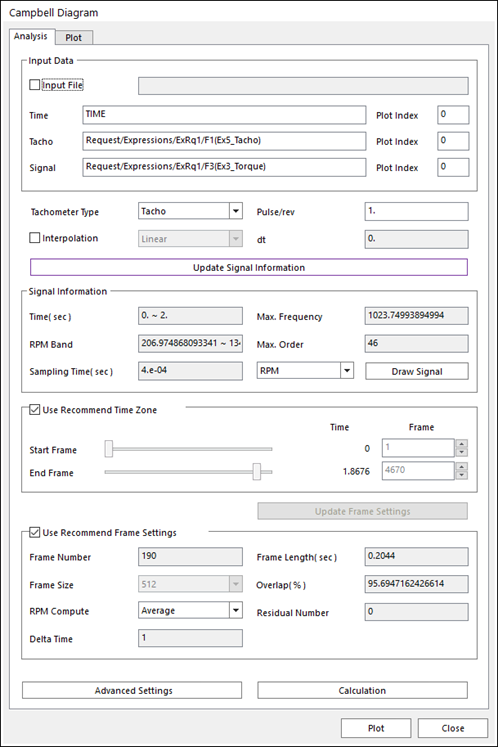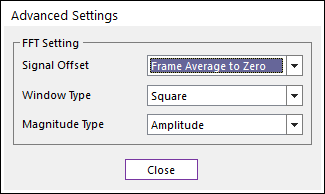

Figure 1 Analysis Tab
Input Data
•Input File: If this option is checked, it uses the imported data file (*.csv) to calculate the Campbell Diagram.
•Note: The 1st row of data file (*.csv) is time, 2nd row is tacho and 3rd row is signal.
•Time: It is time of the data. The time data must match the tacho data and signal data. Easy way to set this data is drag the entity from Plot Database.
•Tacho: The tacho data represents the cyclic trigger signal for the completion of each rotation, in the form of one trigger to one cycle. When this data is inputted in the form of sine function, step function, or impulse function, RecurDyn’s Campbell process must convert it into RPMs before use. Easy way to set this data is drag the entity from Plot Database.
•Note: If the Tachometer Type is RPM or rad/s, input data must be changed accordingly. For more information, refer to Step 0) Preparing the Data.
•Note: In the case of RPM and rad/s, the calculated RPM is defined as a positive number. Therefore, an absolute value function is used for calculating RPM.
•Signal: It is the signal of the data. Easy way to set this data is drag the entity from Plot Database.
•Plot Index: It distinguish data of plot files with index. It is useful when more than one rplt files are loaded.
•Tachometer Type: It changes input type of Tacho with its value. It supports Tacho, RPM, rad/s.
•Pulse/rev: After the user enters the Tacho or RPM or rad/s, the final RPM is multiplied by the Pulse/rev or RPM Multiplier or Multiplier. The default value is '1.' This function is used when the RPM of the entered signal is a multiple of the actual system RPM or when one cycle of the tacho signal is a multiple of the actual cycle.
•Interpolation: When the report step size is not uniform, the Interpolation is necessary. There are two interpolation types, Linear type and Spline type. The user check on the interpolation option, select the interpolation type and insert desired step size and the interpolated signal data will be used for Campbell diagram.
•dt: It is interpolation step size. It is used when Interpolation is applied.
•Update Signal Information: The signal information is updated with this option. It must be used before the user proceeds.
Signal Information
•Time(sec): It shows the time of processed signal.
•RPM Band: It shows the RPM band of processed signal.
•Sampling Time(sec): It shows sampling time of processed signal.
•Max. Frequency: It shows the maximum frequency of processed signal.
•Max. Order: It shows the maximum order of processed signal.
•Draw Signal: It is used to draw the following signals in the Plot. It supports Tacho, RPM, dRPM, Signal, Signal FFT.
Use Recommend Time Zone
The time zone defines the actual data frame used to draw the Campbell diagram when using only a portion of the entire analysis time.
The Use Recommend Time Zone option automatically selects the time zone for which linearity is guaranteed for the RPM data increase rate. If the system calculates the time differential values of the RPMs from the beginning to the end of the data and locates an increase or decrease above a certain value, then the time zone of variance is excluded. If no time zones of variance are found, then the system uses all the data. The user can uncheck Use Recommend Time Zone to customize time zone.
•Start Frame: It is the start frame of time zone.
•End Frame: It is the end frame of time zone.
•Update Frame Setting: The frame setting is updated with this option.
•Note: If Use Recommend Time Zone is unchecked, it must be used before the user proceeds.
Use Recommend Frame Settings
The frame settings specify the size and number of frames to use in the STFT.
Use Recommend Frame Settings option automatically selects the frame size based on the signal information. The system then locates and enters the minimum residual data count for the frame count, which is equivalent to 1/4 count of the frame size. This is determined based on the resolution and half as much frame size is produced as the frequency data. Wherever possible, the count for the X and Y data is also halved. If Use Recommend Frame Settings is unchecked, the user can change the desired setting.
•Frame Number : Specifies frame number.
•Frame Size: Specifies the data count for each frame.
•RPM Compute: Calculates the representative RPMs for each frame using the average or min/max values.
•Frame Length(sec): Specifies the time length of each frame.
•Overlap(%): Specifies the percentage of overlapping data between neighboring frames.
•Residual Number: Specifies the number of data after a decimal point in the remaining data value.
•Calculation: Campbell diagram is calculated using updated signal information and frame settings. It must be used before the user proceeds.
•Delta Time: Delta time is defined as multiplying an integer proportional value multiplying by the input sampling time. Therefore, the integer value shows and can be changed. This option allows to use the partial data among the extracted data rather than all of the data. The user can use this option when having a very long time period, but the response frequency is low.

Figure 2 Advanced Settings
Advanced Settings
•Signal Offset: The signal offset method setting configures the offset for the signal frequency response to time. This function adjusts the frequency using the 0 set. This prevents problems that occur during overall tendency analysis when the low-frequency signal produces too large a value for the 0 frequency. For more information, refer to the Step 6 Configuring the FFT Settings.
•Window Type: Since the signal format for the FFT signal handling cannot begin from 0 and end in 0, the user can use the Window function to adjust the signal format. RecurDyn includes the following Window functions.
•Magnitude Type: The magnitude of the resulting value calculated through the FFT can be expressed as an amplitude, power spectrum or power spectrum density. The user can use the following formulas to calculate these values. For more information, refer to the Step 6 Configuring the FFT Settings.